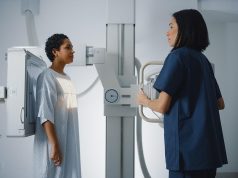Quantitative segmentation algorithm used to extract data from hematoxylin and eosin slides of colorectal cancers
MONDAY, Sept. 12, 2022 (HealthDay News) — The quantitative segmentation algorithm (QuantCRC) may improve the prediction of prognosis in colorectal cancer (CRC), according to a study published online Aug. 16 in Gastroenterology.
Reetesh K. Pai, M.D., from the University of Pittsburgh Medical Center, and colleagues applied QuantCRC to 6,468 digitized hematoxylin and eosin slides of CRCs. From each image, 15 parameters were recorded and tested for associations with clinicopathologic features and molecular alterations. Data from the internal cohort (1,928 tumors) were used to develop a prognostic model for predicting recurrence-free survival (RFS); this model was validated on an internal test cohort and external cohort (483 and 938 tumors, respectively).
The researchers found differences in the QuantCRC results based on stage, histologic subtype, grade, venous/lymphatic/perineural invasion, tumor budding, CD8 immunohistochemistry, mismatch repair (MMR) status, KRAS mutation, BRAF mutation, and CpG methylation. A Harrell’s concordance (c)-index of 0.714 and 0.744 resulted in the internal and external cohorts, respectively, from a prognostic model incorporating stage, MMR, and QuantCRC. The c-index was reduced to 0.679 in the external cohort when QuantCRC was removed from the model. After adjustment for established risk factors, prognostic risk groups were identified for the external cohort, with a hazard ratio of 2.24 and 2.36 for low- versus high-risk stage III CRCs and stage II CRCs, respectively, predictive of RFS. The predicted median 36-month recurrence rate was 32.7 versus 13.4 percent for high- versus low-risk stage III CRCs and 15.8 versus 5.4 percent for high- versus low-risk stage II CRCs.
“For patients with colon cancer, the algorithm gives oncologists another tool to help guide therapy and follow-up,” Pai said in a statement.
Several authors disclosed financial ties to the pharmaceutical, medical technology, and health care industries.
Copyright © 2022 HealthDay. All rights reserved.








